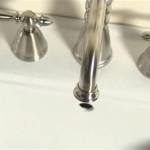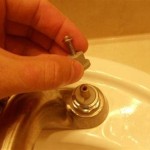All Types of Bathroom Sinks: A Comprehensive Guide
The bathroom sink, often referred to as a washbasin or lavatory, is a fundamental fixture in any bathroom. Its primary function is to provide a convenient space for washing hands, face, and performing other personal hygiene tasks. However, bathroom sinks have evolved significantly beyond mere functionality to become integral components of bathroom design, influencing the overall aesthetic and usability of the space. Selecting the right bathroom sink involves considering several factors, including size, style, material, mounting method, and budget. This article will provide a comprehensive overview of the various types of bathroom sinks available, offering insights into their characteristics, pros, cons, and suitability for different bathroom styles and needs.
The variety of bathroom sinks available on the market can be overwhelming. Categorizing them based on their mounting style is a helpful approach to understanding the different options. The mounting style dictates how the sink is attached to the countertop, wall, or vanity, and significantly impacts the overall look and feel of the bathroom.
Vessel Sinks
Vessel sinks, also known as above-counter sinks, are characterized by their distinctive appearance of sitting directly on top of the countertop. This mounting style reveals the entire basin, creating a focal point in the bathroom. Vessel sinks offer a wide range of design possibilities, as they come in various shapes, sizes, materials, and colors. Common materials include porcelain, glass, stone, copper, and even wood. The exposed design allows for creative expression and can add a touch of elegance or rustic charm to the bathroom.
One of the primary advantages of vessel sinks is their ease of installation. They typically require minimal countertop modification, only needing a hole for the drain and possibly another for the faucet, depending on whether a wall-mounted or countertop-mounted faucet is chosen. This relative simplicity can translate to lower installation costs. Furthermore, vessel sinks often provide a taller washing space compared to other sink styles, which can be more comfortable for some users.
However, vessel sinks also have some drawbacks. Due to their height, they may not be suitable for bathrooms used by small children or individuals with mobility limitations. The elevated position of the sink can make it difficult to reach the faucet and basin comfortably. Additionally, cleaning around the base of the vessel sink, where it meets the countertop, can be challenging. The area is susceptible to water accumulation and soap scum buildup, requiring regular maintenance to prevent stains and mildew growth. Countertop space may also be reduced as the sink itself occupies a significant portion of it.
Undermount Sinks
Undermount sinks are installed beneath the countertop, creating a seamless and clean look. This mounting style allows the countertop material to extend to the edge of the sink opening, providing a smooth, uninterrupted surface. Undermount sinks are typically secured to the underside of the countertop using clips and adhesive, ensuring a stable and watertight connection.
The flush design of undermount sinks simplifies cleaning. Crumbs and spills can be easily wiped directly into the sink without encountering any raised edges or rims. This makes undermount sinks a practical choice for busy bathrooms. Furthermore, the absence of a rim around the sink allows for maximum use of the countertop space, making it ideal for smaller bathrooms where every inch counts. Undermount sinks are frequently paired with solid surface countertops like granite, quartz, or marble, as these materials can be polished to create a smooth and aesthetically pleasing edge.
The installation of undermount sinks is more complex and requires specialized tools and expertise. Precise cutting and polishing of the countertop are necessary to ensure a proper fit and a clean finish. The countertop material must also be strong enough to support the weight of the sink and the water it holds. Therefore, professional installation is generally recommended. Another potential disadvantage is that undermount sinks typically reduce the storage space within the vanity cabinet, as the sink basin resides within the cabinet's interior.
Drop-in Sinks
Drop-in sinks, also referred to as self-rimming sinks, are installed by simply dropping them into a pre-cut hole in the countertop. The rim of the sink rests on the countertop, providing support and concealing the edge of the hole. This installation method is relatively straightforward and can be done as a DIY project, making it a popular choice for homeowners undertaking bathroom renovations.
Drop-in sinks offer a wide variety of styles and materials, ranging from traditional porcelain to contemporary stainless steel. The prominent rim provides a decorative element and can be coordinated with other bathroom fixtures and accessories. Additionally, drop-in sinks are generally more affordable than undermount sinks, making them a budget-friendly option.
However, the rim of a drop-in sink can create a ledge where water and debris can accumulate, making it more difficult to clean compared to undermount sinks. The ledge can also disrupt the smooth flow of the countertop surface. Over time, the sealant around the rim may deteriorate, leading to leaks and water damage. Regular maintenance is required to ensure a watertight seal and prevent the growth of mold and mildew. Because the rim covers the countertop edge, the beauty of the countertop material may be less visible.
Wall-Mounted Sinks
Wall-mounted sinks are attached directly to the wall, without the support of a countertop or vanity. This mounting style creates a minimalist and space-saving design, making it ideal for small bathrooms or powder rooms. Wall-mounted sinks offer a clean and modern aesthetic, emphasizing the architectural elements of the bathroom.
One of the primary advantages of wall-mounted sinks is their ability to maximize floor space. The absence of a vanity allows for easier cleaning and accessibility, making it suitable for individuals with mobility limitations. The height of the sink can also be adjusted during installation to accommodate the specific needs of the user. Wall-mounted sinks can be paired with a decorative trap and supply lines to enhance their visual appeal.
The installation of wall-mounted sinks requires careful planning and structural reinforcement. The wall must be strong enough to support the weight of the sink and the water it holds. Additional framing may be necessary to ensure proper support. The plumbing lines are typically exposed, so choosing attractive fixtures is important. Storage space is limited with wall-mounted sinks, so alternative storage solutions may be needed. Furthermore, running the plumbing through a wall can sometimes be costly.
Pedestal Sinks
Pedestal sinks consist of two main components: a basin and a supporting pedestal. The basin rests on top of the pedestal, which extends to the floor, concealing the plumbing lines and providing support. Pedestal sinks offer a classic and elegant look, often associated with traditional or vintage bathroom styles. They are available in a variety of shapes and sizes, from slender and minimalist designs to more ornate and decorative styles.
Pedestal sinks are a good option for bathrooms where space is limited. They take up less floor space than vanity sinks and provide a clean and uncluttered look. They are relatively easy to install, requiring minimal plumbing connections. The pedestal conceals the plumbing, creating a neat and finished appearance. They are also available in a variety of styles to match different bathroom themes.
Pedestal sinks provide limited storage space. Because the pedestal conceals the plumbing, there is no room for drawers or shelves. They may not be suitable for bathrooms requiring ample storage. The pedestal can also be difficult to clean around, especially in tight spaces. The sink may not have enough counter space. Countertop space is limited, which can be inconvenient for storing toiletries and other bathroom necessities.
Console Sinks
Console sinks are a hybrid between pedestal sinks and vanity sinks. They consist of a basin supported by legs, typically made of metal, and may include a small countertop or shelf. Console sinks offer a blend of style and functionality, providing both a decorative element and some storage space. They are available in a range of designs, from sleek and modern to ornate and traditional.
Console sinks provide more storage space than pedestal sinks. The countertop or shelf offers a place to store toiletries and other bathroom essentials. They also have a stylish and elegant look. The exposed legs add a decorative touch and can complement other bathroom fixtures. They are available in various sizes and styles to suit different bathroom designs. They are easier to clean than pedestal sinks, as the legs provide more access to the floor beneath the sink.
Console sinks are more expensive than pedestal sinks. The added features and materials contribute to a higher price point. They may not be suitable for very small bathrooms. They take up more floor space than pedestal sinks and may overwhelm a small bathroom. The exposed plumbing may be visible, depending on the design. If not properly concealed, the plumbing can detract from the overall aesthetic.
Vanity Sinks
Vanity sinks are integrated into a vanity cabinet, which provides storage space and conceals the plumbing. This is perhaps the most common and versatile type of bathroom sink, offering a wide range of styles, sizes, and configurations. Vanity sinks can be undermount, drop-in, or integrated directly into the vanity countertop.
Vanity sinks offer ample storage space. The vanity cabinet provides room for storing toiletries, cleaning supplies, and other bathroom essentials. They are available in a variety of styles and sizes. There is a vanity sink to suit every bathroom design and budget. They can conceal the plumbing, creating a clean and finished look. The vanity cabinet hides the pipes and drain, improving the overall aesthetic of the bathroom.
Vanity sinks can be more expensive than other types of sinks. The cost depends on the size, style, and materials used. They may take up a significant amount of floor space, especially larger vanity units. This can be a concern in small bathrooms. Installation can be more complex than other types of sinks, requiring plumbing and carpentry skills. Professional installation is recommended for complex installations.
The selection of a bathroom sink requires careful consideration of several factors, including the available space, the desired aesthetic, the budget, and the functional needs of the user. By understanding the characteristics, pros, and cons of each type of bathroom sink, one can make an informed decision that enhances the beauty and functionality of the bathroom.

Types Of Bathroom Sinks The Home Depot

Types Of Bathroom Sinks The Home Depot

16 Diffe Types Of Bathroom Sinks

Types Of Bathroom Basin Drench

Best Types Of Bathroom Sinks Sink Ideas Modernize

Types Of Bathroom Sinks The Home Depot

The Ultimate Guide To Types Of Bathroom Sinks

The Ultimate Guide To Types Of Bathroom Sinks

Types Of Bathroom Basin Drench

Several Types Of Bathroom Lavatory Sink Have Their Own Advantages And Disadvantages
Related Posts







